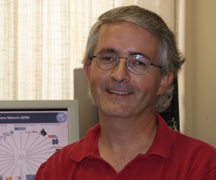
The day may come when we pull into our garages in easily rechargeable electric cars. But the hype surrounding the release of GM’s electric Volt not withstanding, University of Notre Dame engineering professor Paul McGinn’s current project list is proof that the road to that point has many intriguing twists, and more turns than just the ride home from the dealer showroom.
McGinn is one of 20 U.S. researchers invited by the National Science Foundation (NSF) to a brainstorming session this fall on just one approach to creating a truly efficient battery for electric cars. (Right now, car battery technology is too inefficient to support a fully electric car.)
Meeting in early September, the group explored the potential for drug discovery techniques as a means for identifying this new, efficient approach. Researchers looking for pharmaceutical solutions to disease have developed sophisticated ways to identify possible new drugs by using theoretical modeling. The question among the scientists and engineers who met last month is whether theoretical modeling can help rapidly predict viable formulas for new battery production as well.
Underscoring the discussion was an enthusiasm for developing a new battery technology that also would be produced in this country. The latter achievement would make real the notion that new energy solutions will lead to new jobs.
McGinn’s work relates to the step taken after the theoretical modeling. His team has created processing tools and screening instrumentation to combine new chemical compounds and develop performance information to suggest what kinds of problems they might solve. He likens this concept of combinatorial work to the way the three ink colors in a colored printer combine to make a seemingly endless array of new colors.
He applies his research to energy and environmental issues well beyond car batteries, in settings including several in Indiana in which the search for solutions also relates to rebuilding the state’s manufacturing base. In McGinn’s circles, be they at the federal or state level, this work has definitive economic implications.
One instance of another application is a partnership with Cummins Inc. of Columbus, Ind., to eliminate sooty discharges from diesel buses and cars. Cummins was seeking an inexpensive exhaust catalyst so that filters to trap soot from diesel buses and cars can be easily regenerated by combusting the soot. Determining that an inexpensive catalyst could be fashioned from glass, McGinn and his team created a glass composition that"sweats"potassium, which readily combusts soot. (In this case, the compound was more of a revival: the kind of glass that works on this problem was prominent in medieval stained glass windows, he says.)
More relevant to the advent of a truly efficient electric car is McGinn’s longtime work on fuel cells, a promising technology that employs an electrochemical processas opposed to combustionto create energy in a manner that is clean, quiet and more efficient than burning fuel.
This solution could be applied to personal cars, but an early partner in this research is the U.S. Army. Working with the Army Communications and Electronics Command, McGinn’s team has been developing hydrogen fuel cell technology that also could provide portable power to soldiers and other military personnel on the battlefield.
The project also has attracted the attention of economic development organizations in Indiana that are hoping to harness original research on energy to enhance the state’s strong tradition of battery manufacturing.
In the state arena, McGinn has been involved in discussions about plug-in electric vehicles whose stored energy might be able to power some household needs. The question meshes nicely with a state focus on developing a"black box"to accelerate the commercialization of vehicle-to-grid technologies. The box would handle the transfer and conversion of all forms of energy and information between devices, such as the vehicle and the grid, and be able to control things such as the best time for vehicle charging based on grid power availability.
All which is to say that from where McGinn sits, a great deal of energy (pun intended) is being dedicated to developing alternate fuel sources, and many of the concepts have the capacity to transform energy usage as we know it today.
But the developmental process, he cautions, requires the patience that discovery often takes. Put another way, for the time being, there are no electric cars in the McGinn garage, and he expects it will remain that way for awhile.
_ Contact: Paul McGinn,_ " pmcginn@nd.edu ":mailto:pmcginn@nd.edu
TopicID: 30527